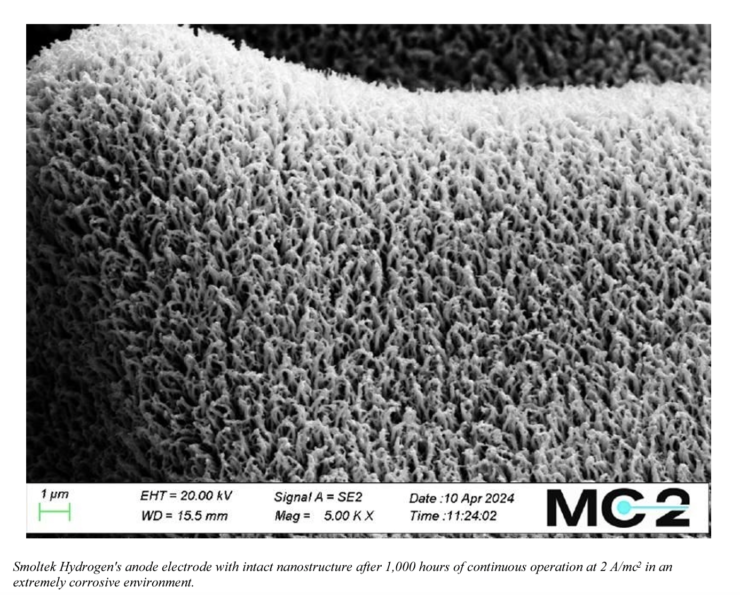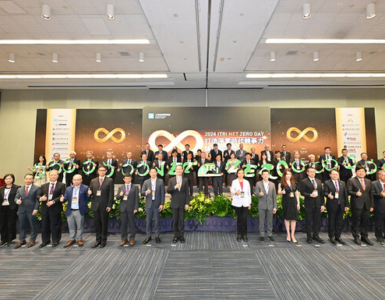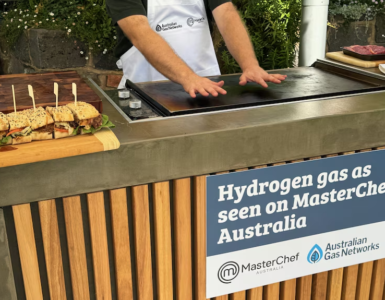Smoltek – cell material for hydrogen electrolysis has successfully passed a 1,000hour durability test with only 0.2 mg of iridium per cm2.
Smoltek Nanotech Holding AB (“Smoltek”) announces successful test results for the company’s cell material for PEM electrolyzers. Group company Smoltek Hydrogen has produced hydrogen during 1,000 hours of continuous operation, with a catalyst loading of only 0.2 mg iridium/cm2. The long-term test shows that the nanofibers in the cell do not corrode, which enables the company to begin adapting the material to specific requirements in collaboration with customers.
Group company Smoltek Hydrogen has completed a successful long-term test of the company’s newly developed material for PEM electrolyzer cells. During 1000 hours of continuous operation, at 2 A/cm2, the company has produced hydrogen with only 0.2 mg iridium/cm2 without any degradation of the nanostructure in the cell having occurred. The material, which consists of a corrosion-protected carbon nanostructure, forms one of the layers in an electrolyzer cell and the technology aims to significantly reduce the amount of iridium used as catalysts to produce hydrogen.
Ellinor Ehrnberg, President of Smoltek Hydrogen, said:
🔥 What about we co-host a webinar? Let's educate, captivate, and convert the hydrogen economy!
Hydrogen Central is the global go-to online magazine for the hydrogen economy, we can help you host impactful webinars that become a global reference on your topic and are an evergreen source of leads. Click here to request more details
We have now proven that our technology with carbon nanofibers, coated with platinum, creates a stable structure in an anode electrode in a PEM electrolyzer.
“Our competitive analysis shows that we are the only one with a working solution for the anode side electrode, which is both durable and creates a large surface area for the iridium catalysts. This represents an important milestone for the company and for our dialogues with collaboration partners”,
Fabian Wenger, head of development at Smoltek Hydrogen, said:
Full-cell performance measurements show that we have performance comparable to conventional solutions, with only one-tenth as much iridium!
“During the first 10 hours of the test, the voltage rises from 2.1 to 2.5 volts, then increases only marginally. This is not abnormal for a process like this in a lab environment and it is something we will optimize in the next step in collaboration with customers, for example by using different types of iridium and perhaps also ruthenium”,
Ellinor Ehrnberg, President of Smoltek Hydrogen, said:
“The thing that has been most questioned during the development of this technology is how we could create such a comprehensive layer of platinum that it can protect the carbon nanofibers against corrosion. Now, after 1,000 hours of continuous operation at 60°C, the fiber structure is intact and we proudly state that we have solved the most important question from both partners and competitors: how to create a stable nanostructure for an extremely thin iridium layer”,
Great progress in a short period of time
In a short time, Smoltek Hydrogen has made great progress towards significantly reducing the amount of iridium in the anode side electrode in electrolyzer cells by using nanofibers as the structure for the catalysis in the cell stack. In the spring of 2023, the company demonstrated that the newly developed material technology with corrosion- protected nanofibers could reduce the amount of iridium by 80 percent compared to a conventional material (0.5 mg iridium/cm2 compared to 2.5 mg iridium/cm2). This in an initial long-term test with an early prototype of the cell material. (Link to last year’s press release)
“Through the establishment of our own development and test laboratory, H2LAB, including collaborations with world-leading researchers and partners, we have been able to accelerate R&D, which has increased the performance of our cell material for PEM electrolysers”, Ellinor Ehrnberg explains.
Smoltek Hydrogen aims to reduce the amount of iridium in the electrolyzer cell towards 0.1 mg/cm2. It is an ambition that aligns with the hydrogen industry’s goal to be able to scale up the production of electrolysers for large-scale production of fossil-free hydrogen. Iridium is a very expensive and critical precious metal with limited supply. Today it costs about SEK 1.7 million/kg and is forecast to cost about SEK 8 million/kg in 2030.
Fact box: Smoltek Hydrogen’s cell material
Smoltek Hydrogen is developing a vertical nanofiber-based material for the anode porous transport layer (PTL) in PEM electrolyzer cells. The material consists of a sintered porous titanium layer with nanofibers, a conformal platinum corrosion protection and iridium catalyst (a thin nanoparticle layer of iridium). The material is one of the layers in an electrolyzer cell. When manufacturing electrolyzers, a large number of electrolyzer cells are assembled into a cell stack, which is the main element in the electrolyzer as it is where the electrolysis takes place and hydrogen is produced.
READ the latest news shaping the hydrogen market at Hydrogen Central
Smoltek – cell material for hydrogen electrolysis has successfully passed a 1,000hour durability test with only 0.2 mg of iridium per cm2.








